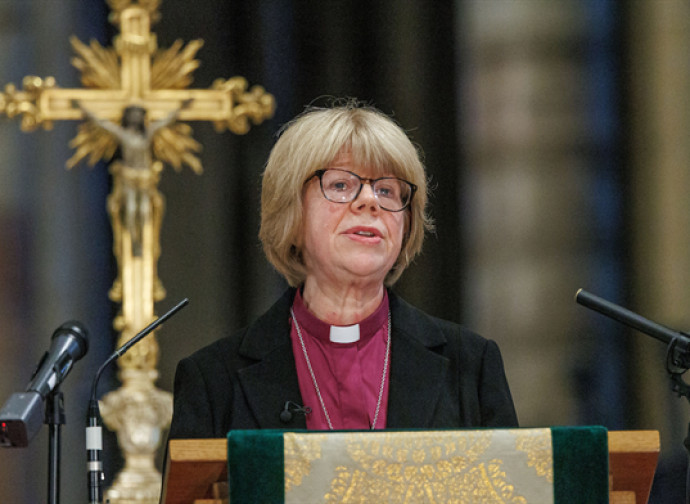The 'Popess' of Canterbury, the culmination of the Anglican shipwreck.
The appointment of Sarah Mullally as Primate of England is the crowning glory of a church disfigured by the forced introduction of changes that some would also like to see in the Catholic Church. However, the safe harbour is the apostolic tradition. Newman's warning applies to Catholics too.

On 1 November, Pope Leo XIV will proclaim St John Henry Newman a Doctor of the Church. Over a century and a half ago, Newman sought to shake up the Anglican Church — his own world — in an attempt to lead it back to the safe harbour of the Apostolic Church and the tradition of the Fathers. He wanted to ward off liberal Christianity’s shipwrecks, which is prone to the spirit of this world. The response of the Anglican authorities was clear: the path chosen by Newman was too 'Roman', too similar to continental Catholicism, and therefore unacceptable. Neither the Anglican hierarchy nor most of his colleagues at Oxford understood that Newman was looking not only backwards to the fourth and fifth centuries of the Church, but also far ahead, sensing the dangerous currents appearing on the horizon.
Ironically, exactly two hundred years after Newman's ordination as a priest in the Anglican Church (1825), a woman has been appointed Archbishop of Canterbury for the first time, becoming the highest spiritual authority in the Anglican Communion and Primate of England. In practice, she is the Anglican 'pope', although the essence and manner of exercising this authority are quite different from those of the Successor of Peter.
Sarah Mullally is a married mother of two, a nurse by profession (a career she left in 2004 to dedicate herself to ministry), and was "ordained" as a presbyter of the Anglican Church in 2002 and as a bishop in 2015. She was appointed by her predecessor, the former Archbishop of Canterbury, Justin Welby, who resigned last year following accusations of covering up a paedophilia scandal. Yesterday, 3 October, the spokesman of the Crown Nominations Commission announced the appointment. The commission is responsible for selecting candidates for the positions of Archbishop of Canterbury and Archbishop of York by a two-thirds majority. These candidates are then presented to the King for approval.
The appointment of Sarah Mullally is not at all surprising. While some agencies and newspapers have reported it as a revolution or a breakthrough, it is in fact the logical consequence of the choice made by the Anglican Church on 11 November 1992 during its Synod, when it was decided that women would be allowed to enter the priesthood. Two years later, on 12 March 1994, thirty-two women were ordained. Another twenty years passed (until 2014), and the democratic vote of the synodical assemblies also opened the doors to the episcopate (note that all holy orders conferred in the Anglican Church are invalid). Even then, it was clear that women could become bishops and reside at Lambeth Palace. Indeed, at the first possible opportunity — Welby was appointed in 2013, a year before the decision on women bishops — the Anglican Church showed the world its decadence.
Moreover, this is the crowning achievement of the logic that Newman denounced as the most dangerous: in the name of an alleged freedom of spirit, the Church is freed from its submission to the tradition of the Fathers and subjected to political decisions and the spirit of the times. As a result of this emancipation, the Anglican Church has come out in favour of women's freedom of choice with regard to abortion and the possibility, in certain cases, of recourse to euthanasia as an expression of Christian piety. It has also recognised and blessed homosexual couples, provided they are in a stable civil partnership following a three-year discernment process called Living in Love and Faith, led by Mullally. Not to mention divorce, which is in its native chromosomal makeup.
The reality of the Anglican world is saddening. Having rejected the outstretched hand of God's mercy, which raised up a new Elijah for the Samaritans in the form of John Henry Newman, it now finds itself plunging towards the abyss with glee and satisfaction. However, even among the highest echelons of the Catholic hierarchy, similar ideas are being tolerated, including those relating to the female priesthood. Numerous bastions have already been shaken, and dangerous breaches have been opened in the various synods under Francis. Examples include communion for divorced-and-remarried couples who continue to live together, which is now a reality in all dioceses; the reopening of discussions on priestly celibacy; the female diaconate; and blessings for same-sex couples. The very meaning of the Synod of Bishops is being subverted, with the laity not only being given the opportunity to intervene, but also to vote — a novelty that is also 'Franciscan', bringing the Synods of the Catholic Church frighteningly close to the tricameral structure of the General Synods of the Anglican Church (House of Bishops, House of Clerics, House of Laity). Let us hope that the similarities end there.



